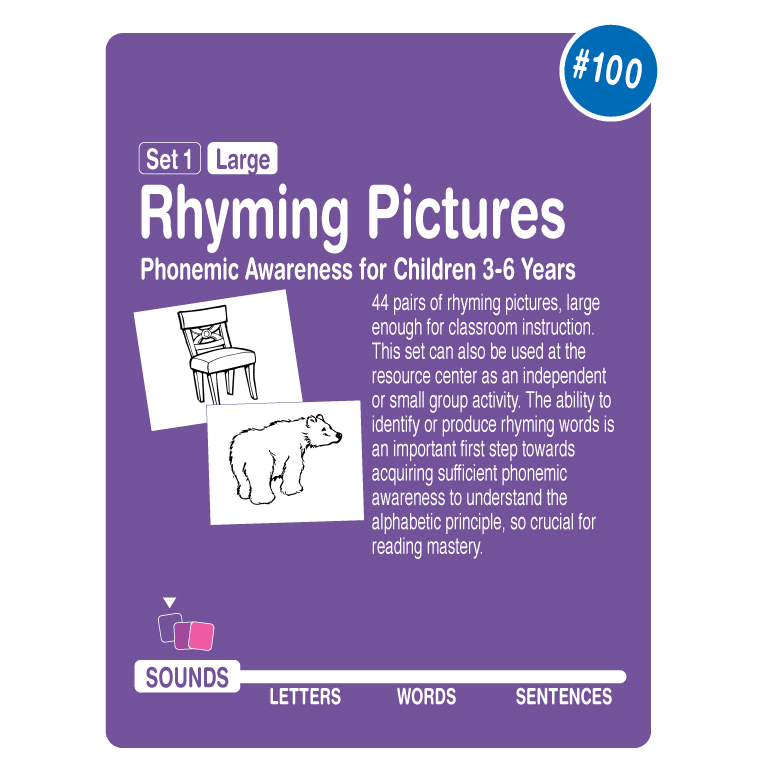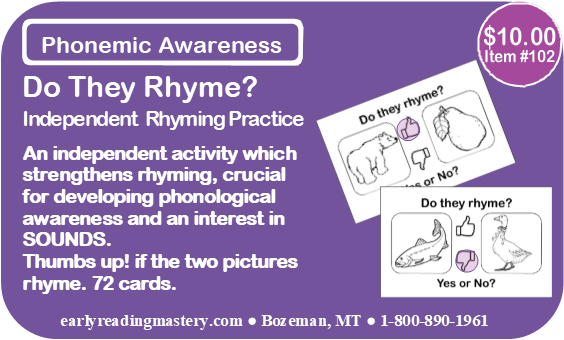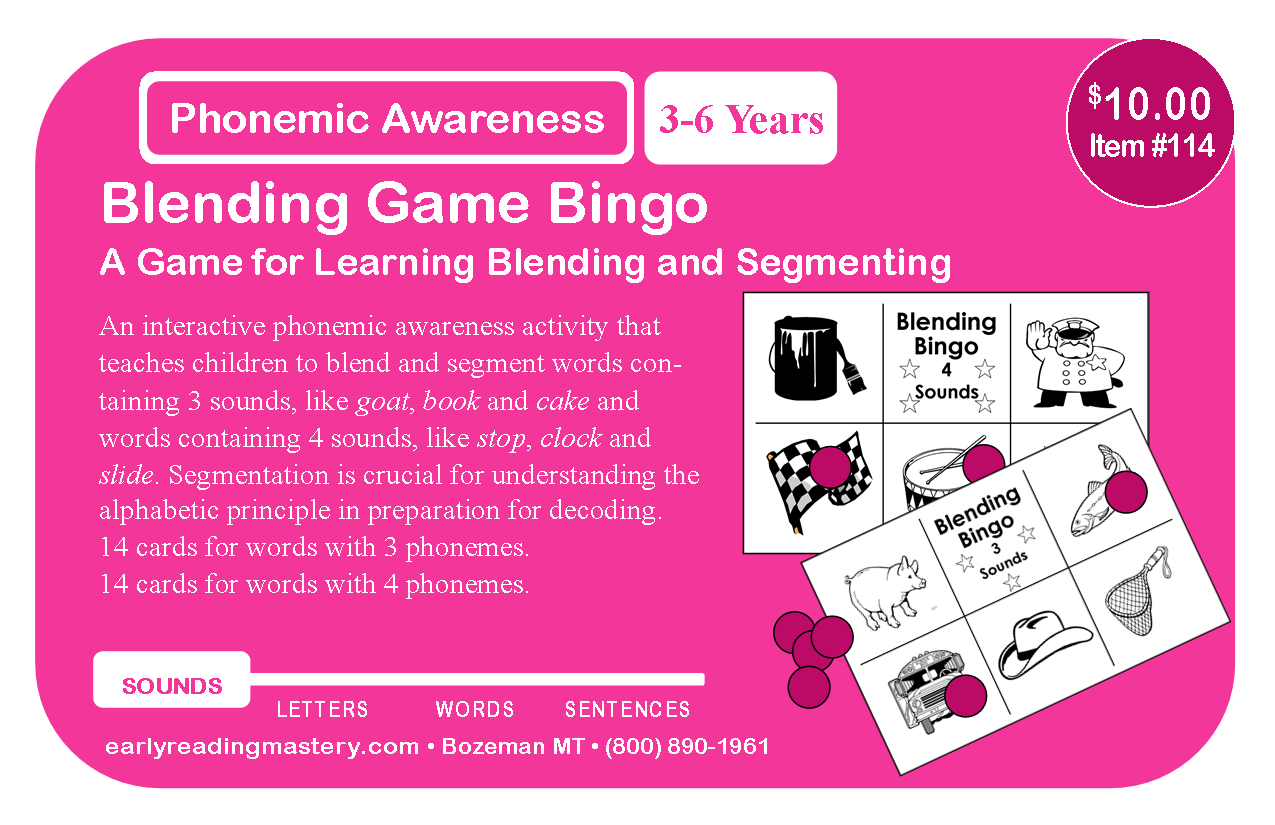Phonemic Awareness
Phonemic awareness is the single most consistent predictor of future reading achievement. Children who enter first grade high in phonemic awareness do well regardless of the kind of instruction they receive. But no method was any better for students who were low in phonemic awareness at the beginning of first grade. All reading begins with phonemic awareness.
Teach Children to Rhyme
Rhyming is considered to be a wonderful way to inaugurate phonemic awareness training with young children. When we rhyme two words (CAT/HAT) we are directing children's attention not to the meaning of those words—there is no relationship there—but to the sounds within those words that are the same. A child who begins to remember rhyming pairs and then starts to generate rhymes (even nonsense rhymes) on his own, is a child who is becoming aware of sounds within spoken language, which is phonemic awareness. So I encourage Kindergarten and preschool teachers and parents to model rhyming often. (Remember, modeling phonemic awareness skills is the best way to teach them.) The more children hear the adults in their learning environment generate rhyming words, the sooner they will begin to generate their own rhymes.
Rhyming Pictures Set 1 [Large]
Rhyming Pictures
Price: $12.00
Item #100
48 pairs of rhyming pictures, for individual or small group instruction. An ideal hands-on manipulative for literacy centers.

Continue reading →
48 pairs of rhyming pictures, for individual or small group instruction. An ideal hands-on manipulative for literacy centers.

Continue reading →
Rhyming Pictures Set 1 [Small]
Rhyming Pictures
Price: $10.00
Item #101
44 pairs of rhyming pictures, large enough for classroom instruction. This set can also be used at the resource center as an independent or small group activity. The ability to identify or produce rhyming words is an important first step towards acquiring sufficient phonemic awareness to understand the alphabetic principle, so crucial for reading mastery.
 Continue reading →
Continue reading → 44 pairs of rhyming pictures, large enough for classroom instruction. This set can also be used at the resource center as an independent or small group activity. The ability to identify or produce rhyming words is an important first step towards acquiring sufficient phonemic awareness to understand the alphabetic principle, so crucial for reading mastery.
 Continue reading →
Continue reading → Do They Rhyme?
Independent Rhyming Practice
Price: $10.00
Item #102
An independent activity which strengthens rhyming, crucial for developing phonological awareness and an interest in SOUNDS.
Thumbs up! if the two pictures rhyme. 72 cards
 Continue reading →
Continue reading → An independent activity which strengthens rhyming, crucial for developing phonological awareness and an interest in SOUNDS.
Thumbs up! if the two pictures rhyme. 72 cards
 Continue reading →
Continue reading → Teach Beginning Sound Isolation.
The child must be taught to isolate and say the beginning sounds of spoken words. The child learns this important phonemic awareness skill by listening to teachers, parents and other classmates model it again and again thr ough oral games. The ability to isolate the beginning sound of a spoken word is the indicator of readiness for learning the alphabet letter-sounds.
Beginning Sound Cards
Independent Beginning Sound Isolation
Price: $10.00
Item #111
The child identifies the beginning sound of the picture at the top of the card, then places game pieces (not included) on the other pictures that start with the same sound. These cards are also effective for individual or small group instruction. 28 cards.


Brief audio explanation of the use of Beginning Sound Cards
DOWNLOAD AUDIO Continue reading →The child identifies the beginning sound of the picture at the top of the card, then places game pieces (not included) on the other pictures that start with the same sound. These cards are also effective for individual or small group instruction. 28 cards.


Brief audio explanation of the use of Beginning Sound Cards
DOWNLOAD AUDIO Continue reading →Same or Different?
Independent Beginning Sound Isolation
Price: $10.00
Item #112
An independent activity which strengthens beginning sound isolation, crucial for understanding the alphabetic principle and learning the sounds of the alphabet.
Thumbs up! if the two pictures have the same beginning sound. 72 cards.
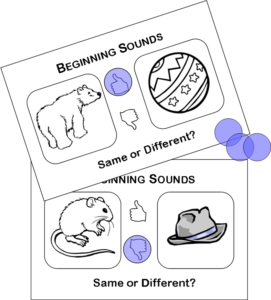
Brief audio explanation of the use of Same or Different?
DOWNLOAD AUDIO
Continue reading →An independent activity which strengthens beginning sound isolation, crucial for understanding the alphabetic principle and learning the sounds of the alphabet.
Thumbs up! if the two pictures have the same beginning sound. 72 cards.

Brief audio explanation of the use of Same or Different?
DOWNLOAD AUDIO
Continue reading →Teach Blending and Segmentation.
The child who is learning to read must be able to listen to sounds (phonemes) spoken to him by an adult (/c/…./a/.…/t/) and blend those sounds into a word he knows (CAT). When playing The Blending Game, the child is hearing the teacher, parent or classmate segment spoken words into sounds again and again. Eventually the child himself will be able to segment spoken language into individual sounds. Note: the number of letters used to spell a word is not important for this game, only the number of phonemes. For example: HOUSE has 5 letters, but only 3 sounds. The Blending Game is the best way to teach a child segmentation, which is a pre-requisite (along with letter-sound mastery) for introducing a child to decoding. Segmentation is the most important beginning reading skill.
Blending Game Bingo
A Game for Learning Blending and Segmenting
Price: $10.00
Item #114
A Game for Learning Blending and Segmenting
An interactive phonemic awareness activity that teaches children to blend and segment words containing 3 sounds, like goat, book and cake and words containing 4 sounds, like stop, clock and slide. Segmentation is crucial for understanding the alphabetic principle in preparation for decoding.


Continue reading →
A Game for Learning Blending and Segmenting
An interactive phonemic awareness activity that teaches children to blend and segment words containing 3 sounds, like goat, book and cake and words containing 4 sounds, like stop, clock and slide. Segmentation is crucial for understanding the alphabetic principle in preparation for decoding.


Continue reading →
The Blending Game Set 1 [3 Sounds]
For Teaching Blending and Segmentation
Price: $8.00
Item #120
An interactive phonemic awareness activity that teaches children to blend and segment words containing 3 sounds, like mouse, church, dog. Segmentation is crucial for understanding the alphabetic principle in preparation for decoding. 59 picture cards.
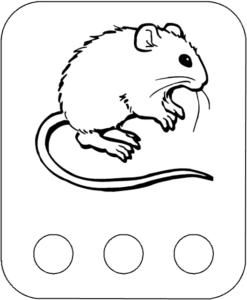

Continue reading →
An interactive phonemic awareness activity that teaches children to blend and segment words containing 3 sounds, like mouse, church, dog. Segmentation is crucial for understanding the alphabetic principle in preparation for decoding. 59 picture cards.


Continue reading →
The Blending Game Set 2 [4 Sounds]
Advanced Blending and Segmentation
Price: $8.00
Item #121
This advanced set consists of vocabulary pictures containing 4 sounds like slide, flag, train. Segmentation of 4 sounds prepares the student to decode 4-letter short vowel words. 53 picture cards.

 Continue reading →
Continue reading → This advanced set consists of vocabulary pictures containing 4 sounds like slide, flag, train. Segmentation of 4 sounds prepares the student to decode 4-letter short vowel words. 53 picture cards.

 Continue reading →
Continue reading → General
The Klein Method of Early Reading Mastery by Randall Klein
Price: $14.50
Item #502
…Teaching Children How to Teach Themselves to Read
Principles of Teaching Children How to Teach Themselves to Read
• Children in large part teach themselves to read
from the instruction and activities we provide
them. They learn how to figure out things on their
own, like unfamiliar phonograms and new spelling
patterns.
• The application of the alphabetic principle to
identify letters and words is the basis of all the activities
in this method and it is how the child will
teach himself to read.
• Effective early reading instruction is based on activities
that guide the student from speech to print,
from sound to symbol and which move from the
concrete to the abstract.
• Teach the alphabetic principle before you teach
the alphabet.
• The foundation of alphabet mastery is beginning
sound isolation.
• Letter knowledge is best learned by the child
through his application of the alphabetic principle
using self-guided materials to match beginning
sounds to printed letters.
• The foundation of reading and spelling words is
phoneme segmentation, the most important beginning
reading skill. Struggling readers often lack
this ability to separate spoken words into individual
sounds.
• Decoding skills are best learned by the child
through his application of the alphabetic principle
using self-guided materials to match sounds of
spoken words to letters in printed words.
• The organization of materials in the environment
is crucial in implementing effective early reading
instruction. The various games and activities
for each skill level are grouped together in
an attractive manner and made easily accessible
to students. This helps to structure the learning
environment so that students understand which
games they may freely choose to work with.
• Freedom to choose is key to gradually shifting responsibility
for learning to the student.
• Freedom to choose individualizes the learning experience
for the student according to his strengths
and interests.
• Teaching is not testing. Don’t ask a student a question
unless you are sure he knows the answer. If
the child gives a wrong answer, that means you’ve
asked the wrong question. If you give him a choice
of answers, he will usually choose the right one.
• Repetition is the teacher’s best teaching tool and
the quickest, most direct way for a student to master
skills and information. Repetition is the healing
balm of education.
• Emphasis must shift from a traditional model of
memorization through drill, to a deeper, more
permanent learning through self-guided handson
activities.
• Do not do for the child what he can do for himself.
…Teaching Children How to Teach Themselves to Read
Principles of Teaching Children How to Teach Themselves to Read
• Children in large part teach themselves to read
from the instruction and activities we provide
them. They learn how to figure out things on their
own, like unfamiliar phonograms and new spelling
patterns.
• The application of the alphabetic principle to
identify letters and words is the basis of all the activities
in this method and it is how the child will
teach himself to read.
• Effective early reading instruction is based on activities
that guide the student from speech to print,
from sound to symbol and which move from the
concrete to the abstract.
• Teach the alphabetic principle before you teach
the alphabet.
• The foundation of alphabet mastery is beginning
sound isolation.
• Letter knowledge is best learned by the child
through his application of the alphabetic principle
using self-guided materials to match beginning
sounds to printed letters.
• The foundation of reading and spelling words is
phoneme segmentation, the most important beginning
reading skill. Struggling readers often lack
this ability to separate spoken words into individual
sounds.
• Decoding skills are best learned by the child
through his application of the alphabetic principle
using self-guided materials to match sounds of
spoken words to letters in printed words.
• The organization of materials in the environment
is crucial in implementing effective early reading
instruction. The various games and activities
for each skill level are grouped together in
an attractive manner and made easily accessible
to students. This helps to structure the learning
environment so that students understand which
games they may freely choose to work with.
• Freedom to choose is key to gradually shifting responsibility
for learning to the student.
• Freedom to choose individualizes the learning experience
for the student according to his strengths
and interests.
• Teaching is not testing. Don’t ask a student a question
unless you are sure he knows the answer. If
the child gives a wrong answer, that means you’ve
asked the wrong question. If you give him a choice
of answers, he will usually choose the right one.
• Repetition is the teacher’s best teaching tool and
the quickest, most direct way for a student to master
skills and information. Repetition is the healing
balm of education.
• Emphasis must shift from a traditional model of
memorization through drill, to a deeper, more
permanent learning through self-guided handson
activities.
• Do not do for the child what he can do for himself.
